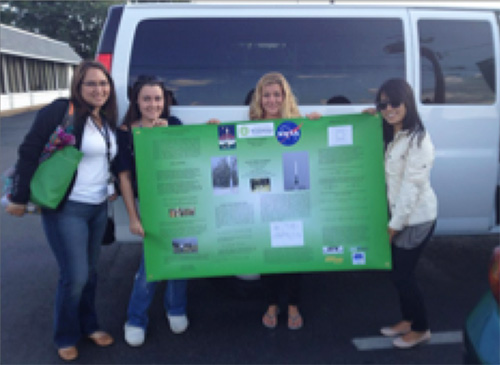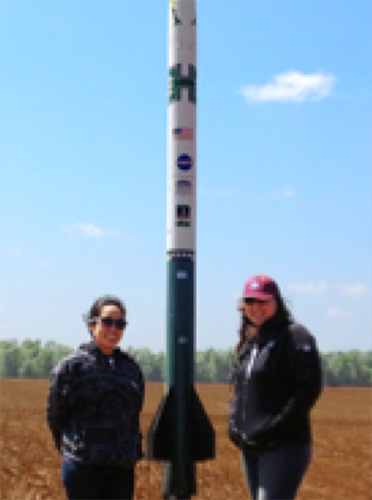Despite A Painful Journey for WCC's USLI Team, their Attitude Wins them the "Team Spirit" Award
by: Patrick Lancaster & Kristi Ross, USLI
Na Huakai Vol.6 2013
Sometimes projects fail even when all the proper procedures have been followed. There is no discipline where this is more applicable than in the aerospace field. This can be extremely frustrating, but should be viewed as a learning opportunity. University of Hawai'i satellite campuses provide students with a chance to experiment and learn within the aerospace community. For the 2011-2012 curriculum year, students from Windward Community College (WCC) partici- pated in the University Student Launch Initiative (USLI).

USLI is a competition hosted by NASA's Marshall Space Flight Center (MSFC) open to colleges across the United States. The competition simulates the design phases, vehicle and payload construction, launch operations and procedures, and safety protocols that are in line with NASA standards. The team must first submit a proposal and be accepted into the program. The proposal must include an elementary vehicle and payload design, budget, schedule, and verify that all safety procedures can be met. In order to be accepted, NASA must be completely convinced that your team can produce a rocket and payload that meets and exceeds all safety and project constraints. After being accepted, teams enter the design phase. The first step in this phase is the preliminary design review (PDR). The purpose of the report is to demonstrate that the overall initial design meets all requirements with acceptable risk and within all cost and schedule constraints.
When this report is submitted, the teams will have explored all design options and the best design will have been selected. It also describes the methods and procedures that will be utilized during construction and development of the vehicle and payload. The next step in the process is the Critical Design Review (CDR). The CDR will demonstrate that the maturity of the project is appropriate to support proceeding to a full-scale fabrication, assembly, integration, and test. This report is a review of the final design of the launch vehicle and payload system, and shows that analyses have been completed and some critical testing has been done. After successful completion of this report, teams are given the go-ahead to begin full-scale fabrication. The final pre-flight report is the Flight Readiness Review (FRR). The FRR covers tests of the full-scale launch vehicle and payload, (including a full-scale launch). This is the final opportunity for the team to prove that the vehicle and project are ready for a successful and safe launch. It ensures that all flight and ground hardware, software, personal, and procedures are operationally ready. Following a launch, successful or otherwise, a Post Launch and Assessment Review (PLAR) is submitted analyzing the flight and sharing all results of the project. Accompanying every report, excluding the proposal and PLAR, the teams must present their projects to a panel of NASA engineers and competition judges. This is an opportunity for the teams to interact, and display their intimate knowledge of their vehicle, payload, and answer any questions the engineers at the Marshal Space Flight Center might have.

The Windward team had the chance to participate in and complete all of this process. This team consisted of Lyra Hancock, Daren Ramos, Patrick Lancaster, Sean Alyward, Rose Wailehua, Jasmine Maru, and Kristi Ross. They had completed the initial stages of the program, with high marks, garnering an invite to MSFC at Huntsville, AL. Things were looking good, that is until the actual launch itself. The team arrived in Alabama on April 18, 2012. The following week, "Launch week," is full of activities that end with the launch of the team’s vehicle. Wednesday was the day that the team arrived, and checked in, at Huntsville. That night, they registered, and were informed of the weeks’ activities. This was also the first night for inspections; each team must de-construct their rockets in the presence of NAR representatives. Once the inspection is done, the team is given a checklist that must be completed before clearance for launch. During the Windward teams’ inspection, they were instructed to replace their shock cords.
The NAR representatives were concerned because the Kevlar shock cords were "singed," and they wanted to prevent the cord from separating. Previous to launch, at the Bragg Farms, the team replaced the shock cord (as was required) and prepared the vehicle for launch.
The ignition of the motor, and ascent of the rocket went well. There were two flight events planned, one at apogee and one at 2500 feet. The drogue chute deployed at apogee, slowing the rocket to ~71 ft/s descent rate. The second event corresponded to the deployment of the 12-foot main chute. There was, unfortunately, one problem at the second event; the new shock cord that connected the booster section to the main parachute (the one that was replaced), separated – brand new, and it snapped! This separation led to the disconnection of the power supply running the payload. Therefore, because the rocket descended too quickly, and no data was obtained, the flight had to be ruled 'unsuccessful.' The team had followed all procedures.
After the launch we attended the banquet that was held at the Space and Rocket Museum, under the last static tested and flight ready Saturn V. This is where NASA presents the awards for the year’s competition. WCC was awarded the team spirit award. So, in conclusion, the event was successful for the team. They got to interact with NASA engineers, build and launch a vehicle and its payload, and learn some humility. Unforeseen events led to a failed launch, but it was fun and educational for those involved.

